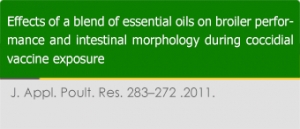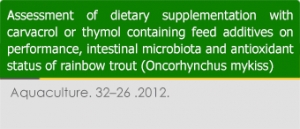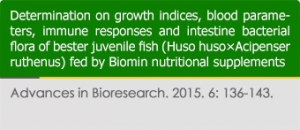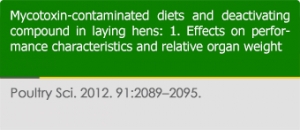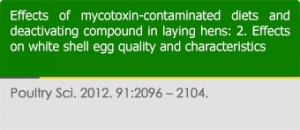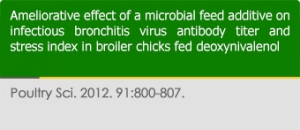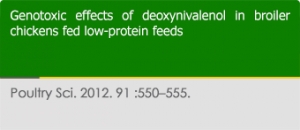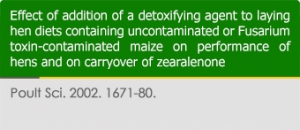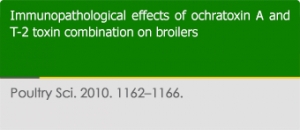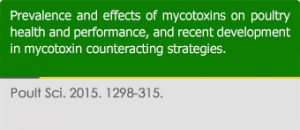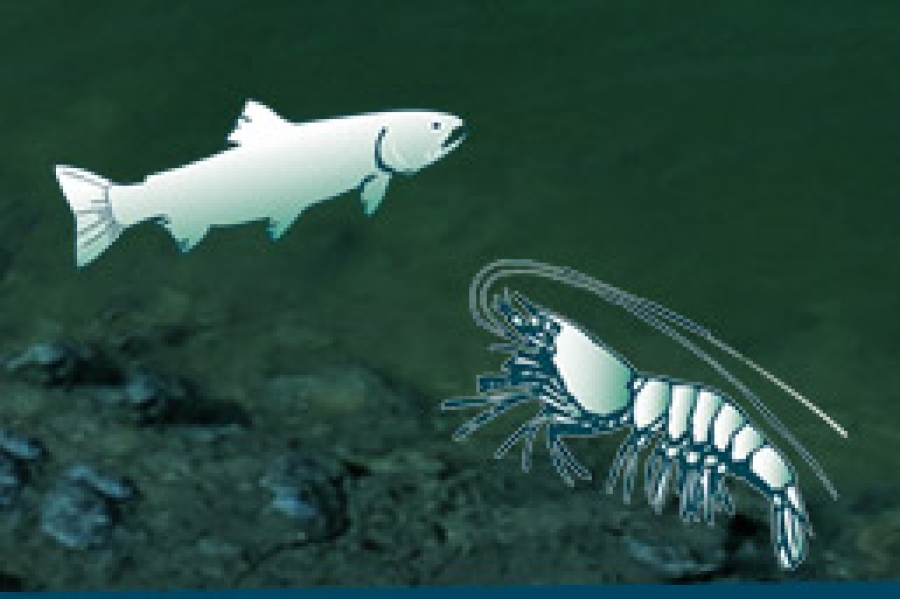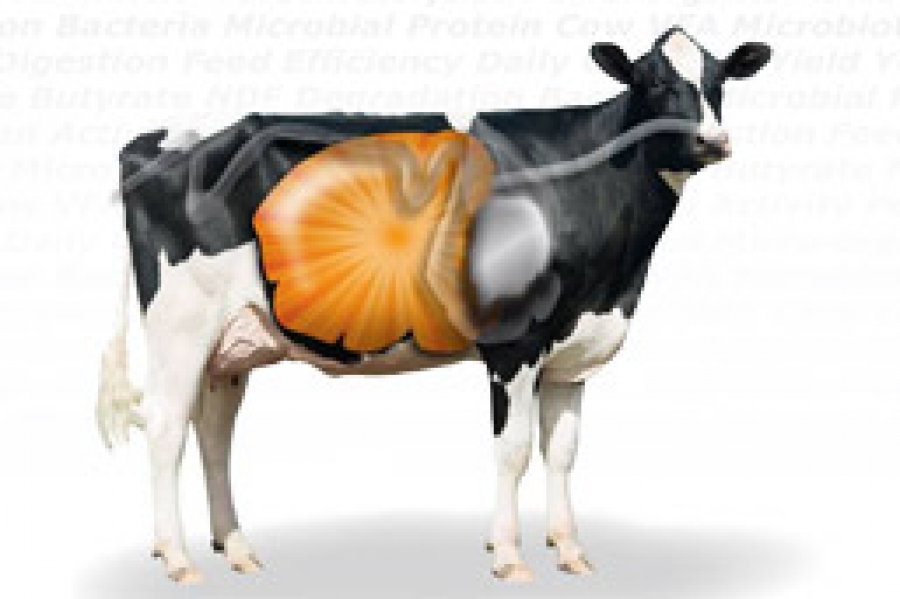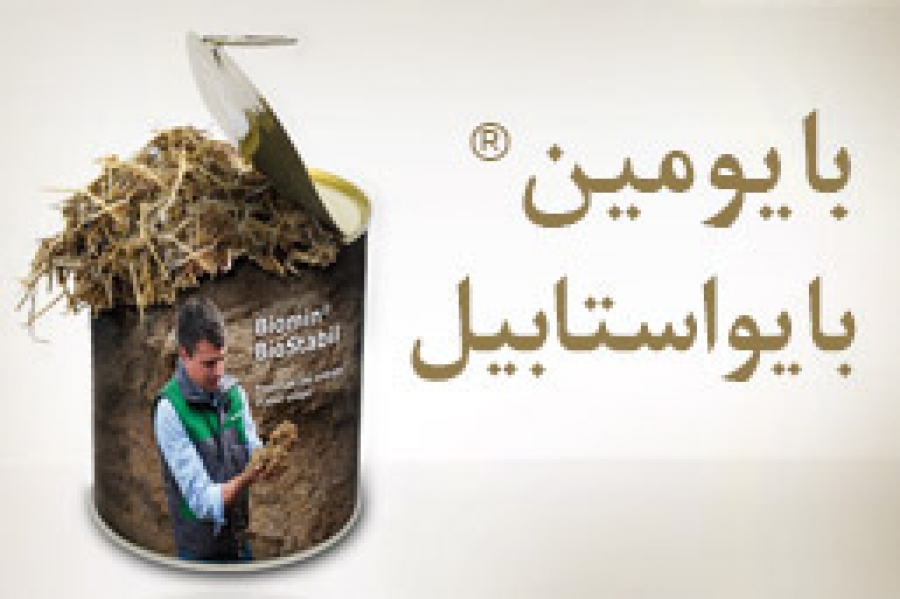Displaying items by tag: گوشتی
N. Reisinger, T. Steiner, S. Nitsch, G. Schatzmayr, and T. J. Applegate
A 2 × 2 factorial experiment (8 pens/treatment, 26 birds/pen) was conducted with 2 doses of a coccidial vaccine [1× or 5× (Paracox-5, Schering-Plough Animal Health, Uxbridge, UK)], administered at 1 d of age) with or without supplementation (125 g/1,000 kg) with a phytogenic feed additive containing a blend of essential oils from oregano, anise, and citrus peel [Biomin P.E.P. 125 poultry (Biomin GmbH, Herzogenburg, Austria); EO]. Within each pen, 13 birds received the coccidial vaccine, whereas the remainder were naturally exposed through the recycling of oocysts in the litter. In pens of birds receiving the higher (5×) dosage of coccidial vaccine, the BW of broilers decreased by up to 2.7% (P = 0.08), but feed-to-gain ratio (FCR) and mortality at 27 d of age (P > 0.05) were not affected.
I. Giannenas, El. Triantafillou, S. Stavrakakis, M. Margaroni c, S. Mavridis, T. Steiner, E. Karagouni
The manipulation and control of fish health and production by natural substances has been identified as an important area for future developments in aquaculture. A study was conducted to investigate the effect of two phytogenic feed additives, one rich in carvacrol (CARV containing 12 g/kg carvacrol) and the other rich in thymol (THYM containing 6 g/kg thymol) on growth performance, gut microbiota and antioxidant status of rainbow trout (Oncorhynchus mykiss) under commercial farming conditions. Groups of 30 sub-adult trout (113.0 g ± 10.4) were randomly allocated into 3 different treatments with three replicates each. The control group was fed a basal diet, while the other two groups were fed diets supplemented with the two phytogenic diets at the level of 1 g/kg.
Fariborz Taghavi, Mehrdad Nasri Tajan, Abbas Ali Zamini
This study is evaluated the effects of Biomin P.E.P supplement on growth indices, blood and immune factors, and intestine bacterial flora of Bester juvenile fish. The survey is conducted on Bester juvenile sturgeons in fisheries laboratory located in Islamic Azad University Science and Research of Guilan Branch in the fall of 1392. The completely random scheme of the research includes 4 treatments each of which has 3 repetitions. The supplement was added to the basal diet on 4 levels of 0, 1, 1/5, and 2 g / kg.72 of 45-g Bester fish were fed for 60 days based on 5 percent of the body weight in 12 tanks (100-liter) that 6 fish in each tank. At the end of the farming period some of the growth indices, blood and immune factors, and intestine bacterial flora were compared.
Lee, J. T., K. A. Jessen, R. Beltran, V. Starkl, G. Schatzmayr, R. Borutova, and D. J. Caldwell
The current experiment was conducted to determine the effect of mycotoxin-contaminated diets with aflatoxin (AFLA) and deoxynivalenol (DON) and dietary inclusion of deactivation compound on layer hen performance during a 10-wk trial. The experimental design consisted of a 4 × 2 factorial with 4 toxin levels: control, low (0.5 mg/kg AFLA + 1.0 mg/kg DON), medium (1.5 mg/kg AFLA + 1.5 mg/kg DON), and high (2.0 mg/kg AFLA + 2.0 mg/kg DON) with or without the inclusion of deactivation compound. Three hundred eighty-four 25-wk-old laying hens were randomly assigned to 1 of the 8 treatment groups. Birds were fed contaminated diets for a 6-wk phase of toxin administration followed by a 4-wk recovery phase, when all birds were fed mycotoxin-free diets.
Lee, J. T., K. A. Jessen, R. Beltran, V. Starkl, G. Schatzmayr, R. Borutova, and D. J. Caldwell
An experiment was conducted to determine the effect of dietary inclusion of Mycofix Select (Biomin GmbH, Herzogenburg, Austria) on discrete egg parameters and quality characteristics of hens fed mycotoxin-contaminated diets (aflatoxin; AFLA) and deoxynivalenol (DON)) during a 10-wk trial. A 4 × 2 factorial design was used with 4 contamination levels: control, low (0.5 mg/kg of AFLA + 1.0 mg/kg of DON), medium (1.5 mg/kg of AFLA + 1.5 mg/kg of DON), and high (2.0 mg/kg of AFLA + 2.0 mg/kg of DON) with or without the inclusion of mycotoxin deactivating compound. Three hundred and eighty-four 25-wk-old laying hens were housed 3 per cage. Birds were fed contaminated diets for a 6-wk phase of toxin administration followed by a 4-wk recovery phase, when all birds were fed mycotoxin-free diets.
Ghareeb, K., W. A. Awad , and J. Böhm
Although acute mycotoxicoses are rare in poultry production, chronic exposure to low levels of mycotoxins is responsible for reduced productivity and increased susceptibility to infectious diseases. Deoxynivalenol (DON) is known to modulate immune function, but only a few studies have investigated the effect of DON on the vaccinal immune response. In addition, the effects of Mycofix select (Biomin GmbH, Herzogenburg, Austria) supplementation to DON-contaminated broiler diets have not yet been demonstrated. Therefore, an experiment with 1-d-old male broilers (Ross 308) was carried out to examine the effects of feeding DON-contaminated low-protein grower diets on performance, serum biochemical parameters, lymphoid organ weight, and antibody titers to infectious bronchitis vaccination in serum and to evaluate
Awad, W. A., K. Ghareeb, A. Dadak, L. Gille, K. Staniek, M. Hess, and J. Böhm
Deoxynivalenol (DON) is one of the most abundant and important trichothecenes in food and feed, and it is a significant contaminant due to its frequent occurrence at toxicologically relevant concentrations worldwide. Deoxynivalenol has negative influences on the health and performance of chicks. However, there is little information available regarding the effect of DON on DNA fragmentation in blood lymphocytes. In addition, the effects of Mycofix select (Biomin GmbH, Herzogenburg, Austria) supplementation to DON-contaminated broiler diets on lymphocyte DNA have not yet been demonstrated. Therefore, the aim of the present study was to establish the effect of DON on lipid peroxidation and lymphocyte DNA fragmentation in broilers and to evaluate the potential of Mycofix select in the prevention of toxin-mediated changes.
Danicke, S., K.-H. Ueberschar I. Halle, S. Matthes, H. Valenta, and G. Flachowsky
16-wk experiment with laying hens was carried out to examine the effects of feeding of mycotoxin-contaminated maize (CM) on performance, nutrient digestibility, weight of organs, serum chemical parameters, and antibody titers to Newcastle disease virus (NDV) in serum. Also tested were fimbrien antigen K88 in egg yolk and zearalenone (ZON) residues in eggs and tissues. The Fusarium-toxin-contaminated maize contained 17,630 microg deoxynivalenol and 1,580 microg ZON/kg. Moreover, Mycofix Plus (MP), a so-called detoxifying agent, was added to both the uncontaminated control (UCM) and to the CM diet (70% dietary maize inclusion). Each of the four resulting diets (UCM, UCM-MP, CM, CM-MP)
Xue, C. Y., G. H. Wang, F. Chen, X. B. Zhang, Y. Z. Bi, and Y. C. Cao
The purpose of this study was to investigate the immunopathological effects of combinations of ochratoxin A (OTA) and T-2 toxin on broilers. Four hundred eighty 1-d-old broilers were randomly assigned to 4 groups, each group consisting of 4 duplicates each with 30 broilers. The 4 groups were fed the following diets for 4 wk: group 1=basal diet (control, mycotoxin-free); group 2=basal diet+2,000 mg/kg of Mycofix Plus; group 3=basal diet+0.25 mg/kg of OTA and 0.5 mg/kg of T-2; and group 4=basal diet+0.25 mg/kg of OTA and 0.5 mg/kg of T-2+2,000 mg/kg of Mycofix Plus. The feeding of OTA-T-2 toxin diets reduced (P<0.05) the level of anti-Newcastle disease virus antibody titers by 10.4%. When broilers were administered
Murugesan, G. R., D. R. Ledoux, K. Naehrer, F. Berthiller, T. J. Applegate, B. Grenier, T. D. Phillips, and G. Schatzmayr
Extensive research over the last couple of decades has made it obvious that mycotoxins are commonly prevalent in majority of feed ingredients. A worldwide mycotoxin survey in 2013 revealed 81% of around 3,000 grain and feed samples analyzed had at least 1 mycotoxin, which was higher than the 10-year average (from 2004 to 2013) of 76% in a total of 25,944 samples. The considerable increase in the number of positive samples in 2013 may be due to the improvements in detection methods and their sensitivity. The recently developed liquid chromatography coupled to (tandem) mass spectrometry allows the inclusion of a high number of analytes and is the most selective, sensitive,



